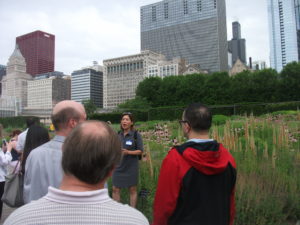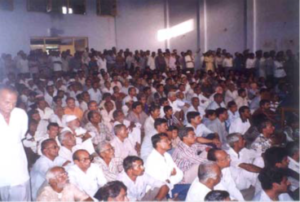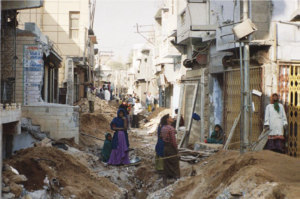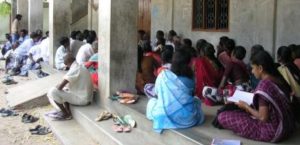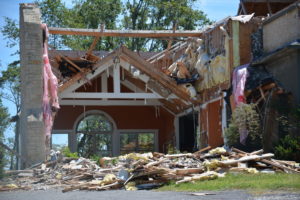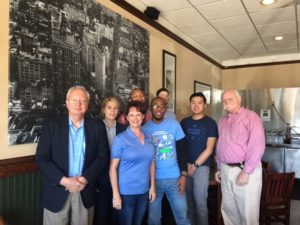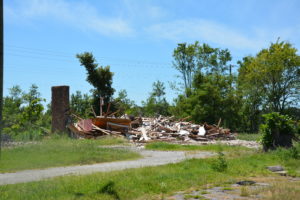Ed Uhlir died Wednesday, not living long enough to enjoy another Thanksgiving because multiple myeloma overtook him at 73. But the entire Chicago region can be thankful for his quiet service to the city and for his major accomplishment as both an architect and a public servant.
 In a world of “starchitects,” those designers with rock-star name recognition in their highly visible profession, his creativity was of a different and far less flamboyant sort. He succeeded in orchestrating the contributions of numerous rich, powerful, and sometimes difficult personalities to produce an outcome that changes people’s perceptions of what a major public space can be. He spent six years, starting in 1998, as the project director for Millennium Park. Mayor Richard M. Daley persuaded him to take on the role shortly after he had retired from the Chicago Park District, with plans to enter the private sector. Daley told him the job would last a couple of years. It ended up being six, but Uhlir stuck with the task until the 26-acre Millennium Park opened in 2004, completely transforming the lake side of Michigan Avenue for several blocks south from Randolph St. to Monroe St. In the process, it also transformed everyone’s sense of downtown Chicago.
In a world of “starchitects,” those designers with rock-star name recognition in their highly visible profession, his creativity was of a different and far less flamboyant sort. He succeeded in orchestrating the contributions of numerous rich, powerful, and sometimes difficult personalities to produce an outcome that changes people’s perceptions of what a major public space can be. He spent six years, starting in 1998, as the project director for Millennium Park. Mayor Richard M. Daley persuaded him to take on the role shortly after he had retired from the Chicago Park District, with plans to enter the private sector. Daley told him the job would last a couple of years. It ended up being six, but Uhlir stuck with the task until the 26-acre Millennium Park opened in 2004, completely transforming the lake side of Michigan Avenue for several blocks south from Randolph St. to Monroe St. In the process, it also transformed everyone’s sense of downtown Chicago.
During those six years, I watched from a bird’s-nest view of what is now the park because the American Planning Association (APA) was situated across Michigan Avenue from the Art Institute of Chicago and catacorner from the park’s edge. I have regretted to this day not having had the foresight to start shooting daily photos from that 12th-floor vantage point to create a record of its progress toward completion. I had the corner office closest to the action. But who knew?
 Well, some did. In late June of this year, I attended, on an intermittently rainy day, a tour of Millennium Park, co-sponsored by the APA Illinois chapter and the American Society of Landscape Architects Illinois chapter. The program began in a meeting room behind the park’s amphitheater with a series of short presentations led by Uhlir, who was remarkably candid about the process of creating the park. But retirement can do that to you.
Well, some did. In late June of this year, I attended, on an intermittently rainy day, a tour of Millennium Park, co-sponsored by the APA Illinois chapter and the American Society of Landscape Architects Illinois chapter. The program began in a meeting room behind the park’s amphitheater with a series of short presentations led by Uhlir, who was remarkably candid about the process of creating the park. But retirement can do that to you.
What Uhlir began with was a park design by the firm Skidmore Owings and Merrill (SOM) that he found unsatisfactory, he said, in part because it was not completely accessible, though it was based on “an extension of details from the Burnham plan.” Exactly what that meant historically was laid out by Benet Haller, who had been with the Chicago Department of Planning and Development, but now is a transit manager for Cook County. He followed Uhlir’s presentation with a discussion of the history of the downtown lakefront area that Grant and Millennium Parks now occupy, which more than a century ago grew from landfill, much of it derived from subway tunneling as the city’s transit system was built. Haller noted that the Chicago lakefront has been evolving for decades, with features like Grant Park’s iconic Buckingham Fountain emerging in the 1950s. Evolution is, of course, precisely what one would expect of a dynamic urban area. Michigan Avenue, now several blocks from the lake, gained its name from originally being along the lake. Also along that lakefront was a stretch of railroad that still provides passage for many riders into downtown along Metra’s Electric Line, now ending below ground in a station under Millennium Park.
As Terry Guen, a local landscape architect who also spoke, noted, city lawyers discovered by 1998 that the city owned in fee simple the land between Randolph and Michigan, easing the task of leveraging use of the land from railroads that opposed its use for a park. In addition to the Metra station, the space below the park also contains a parking garage, making the park above, as Guen observed, “the world’s largest publicly accessible green roof.”
Achieving that status required a discreet but confident man with a sense of humor who could patiently weather the tug of war between wealthy donors (such as Penny Pritzker), who underwrote many of the most significant improvements to the park; world-famous architects like Frank Gehry; Maggie Daley, the mayor’s wife; who insisted on accessibility for the entire park; and civic and business leaders. After the initial design failed, Uhlir shifted the approach to a design competition that attracted some of the best ideas that found their way into the final scheme, including the proposal from Anish Kapoor for “Cloud Gate,” aka “the Bean,” one of the most popular aspects of the park since its opening because it allows visitors to see both themselves and the city skyline in the reflections on the perfectly buffed metal. Despite early criticism about cost overruns, the park has become the leading tourist attraction in Illinois, outpacing even Navy Pier with approximately 13 million visitors annually. It is a dynamic combination of features—the water fountain, the amphitheater, a winter skating rink, the “Bean,” and gardens that blend into an effective whole that seems always to be greater than the sum of its parts.

 Part of the magic, according to Guen, came from tapping the local wisdom of “plant people, contractors, and others who knew so much about Chicago,” bringing wildflowers and prairie plants that bring an explosive mix of colors while allowing “little weed growth because the ground is so packed full of roots.” The botanical features of Millennium Park can keep a native plant enthusiast busy all summer long, even as the built features attract audiences seeking cultural experiences. For instance, the Harris Theater, on the northeast corner, attracted my wife and me on our anniversary one year to hear Roberto Bernigni perform a comic monologue followed by a recitation in Italian from Dante’s “Il Inferno.” We returned on my birthday to join a “do-it-yourself Messiah,” in which audience members participate in singing assigned parts of Georg Friedrich Handel’s famous work.
Part of the magic, according to Guen, came from tapping the local wisdom of “plant people, contractors, and others who knew so much about Chicago,” bringing wildflowers and prairie plants that bring an explosive mix of colors while allowing “little weed growth because the ground is so packed full of roots.” The botanical features of Millennium Park can keep a native plant enthusiast busy all summer long, even as the built features attract audiences seeking cultural experiences. For instance, the Harris Theater, on the northeast corner, attracted my wife and me on our anniversary one year to hear Roberto Bernigni perform a comic monologue followed by a recitation in Italian from Dante’s “Il Inferno.” We returned on my birthday to join a “do-it-yourself Messiah,” in which audience members participate in singing assigned parts of Georg Friedrich Handel’s famous work.
All Ed Uhlir did to make this happen was keep all the egos in check, harness them toward a common goal, and leave Chicago with a lasting civic treasure where people can rest, recreate, and relish the best the city’s culture has to offer. If that is the only legacy for which he is remembered, it is far more than most of us will ever claim. Millennium Park is now an indelible part of Chicago’s identity.
Jim Schwab

